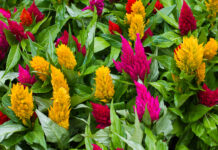
Do you have a shady spot in the yard that you’re not quite sure what to do with? Enliven your garden with these shade-loving perennials that have beautiful blooms and fun foliage. Adding some color to low-light areas is a great way to brighten up your space. Here are some of our favorite blooming shade perennials that we use at the Birmingham Botanical Gardens.
Astilbe
Sometimes referred to as false goat’s beard or false spirea, astilbe is a clump-forming perennial that thrives in the shade and can tolerate wet sites. In spring, fern-like leaves emerge dark green with hints of bronze. In summer, feathery plumes extend above the foliage in varying hues of red, pink, purple, or white. Leave the spent plumes for winter interest. Astilbe is deer and rabbit resistant, and the flowers are perfect for floral or dried arrangements.

Hellebores
Popularly called Lenten roses, hellebores (Helleborus spp.) thrive in the shade but can handle some sun. This clumping, evergreen perennial begins blooming in winter and welcomes us into spring. Lenten roses have cup-shaped, downward-facing flowers that come in a wide array of colors and petal count. Hellebores will naturally multiply over time through self-seeding and root division, so they can slowly spread into a ground cover.

Heuchera
Commonly known as coral bells, heuchera is typically chosen for its colorful, unique foliage. It produces tiny, bell-shaped flowers that are coral/pink in color and attract bees and butterflies. Heuchera has a low, mounding growth habit, so it does well as a ground cover or in containers. There are countless varieties of coral bells, all with different leaf color, size, and shape. One of our favorite varieties to use is called ‘Alabama Sunrise,’ which has chartreuse leaves with bright red veins.

Tricyrtis
Tricyrtis (Tricyrtis spp.) is a fall-blooming perennial with small, orchid-like flowers. Also called toad lily, the exotic-looking plant is aptly named for its warty, sac-like bumps resembling a toad’s skin at the base of its spotted flowers. Due to the small, detailed nature of its blooms, toad lilies are best appreciated along borders or paths where they can be observed up close. Here at the Gardens, we especially love Hairy Toad Lily (Tricyrtis hirta) for the added uniqueness in foliage texture.

Trillium
A genus of herbaceous perennials that thrive in woodland sites, there are around 18 species of trillium native to Alabama. These wildflowers begin to pop up throughout the forest floor in early spring. Trilliums do not produce true leaves or stems, as the above-ground growth is a flowering scape. What we view as “leaves” are actually inflorescence bracts below the flower. They are green or mottled in whorls of three, and the blooms are solitary with three petals and three bracts. Petal colors differ by species and can be white, yellow, or hues of reds and pinks. Trilliums can multiply via underground rhizomes or by seed. However, it can take five or more years for a trillium to mature and bloom from a seed.
Birmingham Botanical Gardens // bbgardens.com





